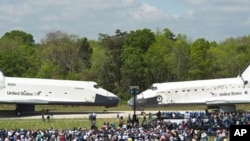Astronauts who journeyed to space on the shuttle Discovery welcomed the orbiter to its new home Thursday at the Smithsonian National Air and Space Museum's Steven F. Udvar-Hazy Center in Chantilly, Virginia.
The U.S. Drum and Bugle Corps played beneath bright blue skies as Discovery was towed toward its hangar at the museum. A line of astronauts in blue jumpsuits who had flown on Discovery escorted the spacecraft in front of cheering crowds.
But before Discovery could enter its hangar, it came nose-to-nose with the museum's former showpiece, the space shuttle prototype Enterprise. It had never ventured into space and will soon be ferried to a museum in New York City.
The shapes were the same. But Enterprise gleamed, white and shiny.
NASA Administrator Charles Bolden said it was clear that Discovery had weathered 39 missions.
"I know we describe it as white, but you'll notice it's charred a little bit," Bolden said. "Try going through 3,000 degrees and see if you don't get a little charred, okay? Shuttles showed us that Earth orbit could be an extension of our human biosphere, a place where we could live and work."
Astronaut John Glenn was the first American to orbit the Earth in 1962. He returned to space on Discovery in 1998. The former U.S. senator from Ohio praised Discovery's legacy, but lamented the end of the space shuttle era.
"Discovery truly was a heavy hauler in construction of the International Space Station, and that station is now doing continuing research with 15 international partners for us in the most unique scientific laboratory ever conceived," Glenn said. "The unfortunate decision made eight-and-a-half years ago to terminate the shuttle fleet, in my view, prematurely grounded Discovery and delayed our research. But those decisions have been made and we recovered and now we move on with new programs and possibilities unlimited."
NASA is now focused on developing the next generation of spacecraft that can go beyond low earth orbit.
To those who know Discovery well, the orbiter looked as if it were ready to fly again.
John Grunsfeld, a former NASA astronaut who flew on Discovery, said when he first glimpsed the shuttle outside the museum, it reminded him of seeing it at NASA's Kennedy Space Center in Florida.
"It sort of looked like Discovery was ready to be pulled into the orbiter processing facility, getting turned around for its next flight. And so there's just a hint of sadness," Grunsfeld said. "And then I thought, 'Well, Discovery is coming for its next flight. It's the flight of imagination that kids will have seeing Discovery because it is such an amazing vehicle, the space shuttle.'"
After nearly three decades and 135 missions, all of NASA's space shuttles are now part of history. The other orbiters will join museum collections in Florida, New York and California by the end of this year.






